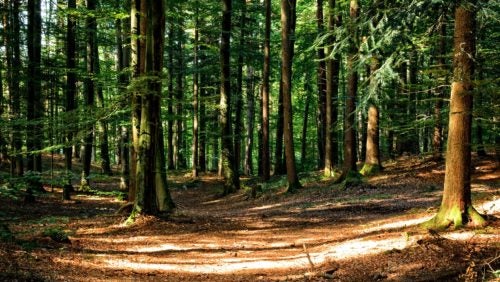China’s Green Desert
March 28, 2019 by Timothy Park

China has been one of the largest contributors to reforestation efforts through its Grain for Green Program. However, have all of their efforts actually helped the environment? One fatal flaw in the program is severely limiting the programs impact on the environment.
China’s Grain for Green program is helping mitigate climate change, but misses an easy opportunity to create new habitats for wildlife to flourish in.
As deforestation becomes increasingly common, efforts towards reforestation on a large scale become more important. China’s Conversion of Cropland to Forest Program, commonly known as the “Grain for Green” program, is an example of a nation actively working towards reforestation.[1] According to NASA, the world is becoming a greener place, and China has made a large contribution towards greening the earth.[2] Despite its contribution towards reforestation, the Grain for Green program fails to introduce biodiversity to the land.
The Grain for Green program began in 1999.[3] The program’s focus was to convert cropland to forest to prevent soil erosion and combat climate change.[4] The program encourages reforestation by paying rural farmers who plant trees on their farmland. This has resulted in a massive increase in the number of forests in China. NASA research has shown that China and India have contributed one-third of the world’s increase in greening since the early 2000s.[5] This increase in forests has made positive impacts on our environment. Another study has shown that the Grain for Green program has highly increased the amount of soil organic carbon present in the area.[6]
While the program has made positive impacts towards mitigating climate change, the program fails to introduce any sort of biodiversity in the reforested areas. The payment structure is focused on the area of the land being reforested rather than the value of the reforestation.[7] As such, farmers have largely focused on planting only the species promoted by the program because those species were more profitable.[8] In doing so, reforestation efforts have largely created monoculture forests. Furthermore, many of these forests are comprised of trees that are not native to the geographic area.[9] These two factors hinder native wildlife in the area. A study by Princeton researched the presence of birds and bees, which can be used to estimate the general biodiversity in an area, in forests created by the Green for Grain program.[10] The research showed that both birds and bees were noticeably lacking in reforested areas.[11] In other words, the general biodiversity in the reforested areas was quite poor.
While the increase in trees may help combat soil erosion and air pollution, it is doing very little to help biodiversity. The program is missing an opportunity to contribute a great deal to wildlife. There are many possible steps that Grain for Green could take to improve its program to help the environment. Two simple solutions would be to use trees native to the area and to use a diverse number of tree species. Both have been found to encourage biodiversity in an area.[12] These solutions do not require a large overhaul to the current system and are relatively inexpensive. By rewarding the use of native or diverse tree species, farmers will be incentivized to move away from the monoculture forests that are currently favored. The program could also work with local organizations to help facilitate this goal. For example, the California Forest Improvement Program (CFIP) is a state funded program aimed at encouraging private and public reforestation efforts.[13] CFIP works with local organizations, such as the El Dorado County Resource Conservation District, to help landowners acquire healthy seedlings that are appropriate for their geographic location.[14] These steps could all further biodiversity without incurring great costs.
Even without any changes to their current program structure, Grain for Green is evidence that reforesting programs can make a noticeable positive impact on the environment and towards combating climate change. Nevertheless, the program is missing an opportunity to help local wildlife as well.
[1] K. Zhang et al., China’s Conversion of Cropland to Forest Program as a National PES Scheme: Institutional Structure, Voluntarism and Conditionality of PES, 19(S4) Int’l Forestry Rev. 24, 25 (2017).
[2] Abby Tabor, Human Activity in China and India Dominates the Greening of Earth, NASA Study Shows, NASA (Feb. 11, 2019), https://www.nasa.gov/feature/ames/human-activity-in-china-and-india-dominates-the-greening-of-earth-nasa-study-shows.
[3] Zhang, supra note 1.
[4] Id.
[5] Tabor, supra note 2.
[6] Song et al., Chinese Grain for Green Program Led to Highly Increased Soil Organic Carbon Levels: A Meta-Analysis, 4 Scientific Reports 1, 1 (2014).
[7] Zhang, supra note 1.
[8] Morgan Erickson-Davis, Study Reveals China’s New Forests Aren’t Really Forests, Mongabay (June 7, 2018), https://news.mongabay.com/2018/06/study-finds-chinas-new-forests-arent-really-forests/.
[9] B. Kelly, Seeing the Forest for the Trees: World’s Largest Reforestation Program Overlooks Wildlife, Princeton University (Sept. 7, 2016), https://www.princeton.edu/news/2016/09/07/seeing-forest-trees-worlds-largest-reforestation-program-overlooks-wildlife.
[10] Id.
[11] Id.
[12] Id.
[13] Cal. Fire, California Forest Improvement Program, http://calfire.ca.gov/resource_mgt/resource_mgt_forestryassistance_cfip.
[14] Id; El Dorado County and Georgetown Divide Resource Conservation Districts, Reforestation, http://www.eldoradorcd.org/nodes/info/reforestation.htm.

